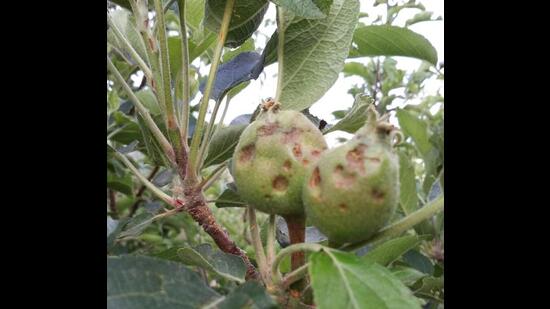Fungal European blight hits apple crop amid high humidity in Himachal Pradesh
Combination of less rain last winter and intermittent rainfall in June this year created an environment conducive to disease development.
The onset of the monsoon season has brought disease and pests to the apple crop in Himachal, putting the quality of the fruit at risk. High humidity levels have led to an outbreak of Alternaria, a fungal disease that causes leaf blotch, fruit spots and mouldy core diseases and blight.

A team of scientists from Dr YS Parmar University of Horticulture and Forestry in Nauni found that the disease has spread across orchards in major apple-growing regions of the state.
The university sent out teams to the field after receiving samples showing Alternaria leaf spotlight and other leaf spot diseases. The teams, comprising plant pathologists, entomologists, and other experts, visited apple-growing areas in Shimla district on July 11 and 12 to diagnose diseases and insect pest attacks on apples.
They found that the disease had spread rapidly, with yellow and brown spots appearing on leaves and spreading from one orchard to another.
Each team consists of a plant pathologist, an entomologist, and other experts. They visited the apple-growing areas of Shimla district on July 11 and 12 to diagnose diseases and insect pest attacks on apples.
The outbreak of diseases has raised concern for the apple growers.
“Yellow and brown spots have appeared on the leaves, spreading fast from one orchard to another,” Vishal Singh, an apple grower from Anu Basa in Rohru said, adding, “If the diseases are not controlled, it will lead to defoliation of leaves hampering the fruit quality which is nearing harvest in the orchards situated in the lower elevations.”
The farmers pushed for more coordinated efforts from the government’s end.
“There is hardly any coordination between the government departments. The research being done inside closed doors is not reaching the farmers. There are hardly any field camps being organised by the universities to educate farmers,” Rajpal Singh Chauhan, a progressive apple grower from Dumehar village, said.
Progressive Apple Growers president Lokinder Singh Bisht, meanwhile, said, “There is no new disease. Alternaria, fungal and bacterial blight, rust, necrotic leaf blotch and anthracnose have been infecting orchards almost every year, however this year it has reached epidemic proportions, mainly due to the extremely high levels of humidity and failed monsoon has spread mite and stress and weakened the leaves making them more susceptible to these diseases.”
Diseases symptoms
The disease thrives in environments with high humidity and shade and its symptoms are most pronounced in these conditions.
In the early stages of infection, Alternaria causes circular dark green spots to appear on the upper surface of apple leaves. As it progresses, these spots turn brown and eventually dark brown, while the remaining parts of the leaves turn yellow. The spread of the disease leads to premature defoliation, which can have devastating consequences for the fruit.
Varsity issues advisory
The Dr YS Parmar varsity’s department of plant pathology issued an advisory to apple farmers to effectively manage the apple foliar diseases reported from some areas of the state.
Alternaria and other fungal species were identified as the primary causal agent of these leaf spot/blight disease based on observed symptoms and microscopic observations.
The disease exhibited a widespread distribution, recording variable levels of average disease severity in different orchards of the district — Kotkhai 0-30%, Jubbal 0-20%, Rohru 0-20%, Chirgaon 0-15%, Theog 0-10%, Chopal 0-4 %. However, farmers following proper need-based spraying of pesticides depicted minimum disease severity.
The varsity has also deputed four new teams to visit other apple growing belts of the state and assess the severity of the disease.
“Apple farmers are advised to take immediate measures to prevent the spread of Alternaria disease, which can cause significant damage to crops. To manage the disease, farmers should enhance air circulation through proper pruning, remove weeds and infected plant debris, and manage soil moisture levels. Appropriate fertilisation and judicious use of fungicides and insecticides are also recommended,” the advisory read.
Alternative leaf spot/blight and other leaf spots can be managed by spraying mancozeb or alternative formulations. Mite management can be achieved by spraying Fenazaquin, Propargite, or Cyenopyrafen.
Farmers were further advised not to repeat the same miticides and to investigate alternative management strategies such as regenerative farming practices.




